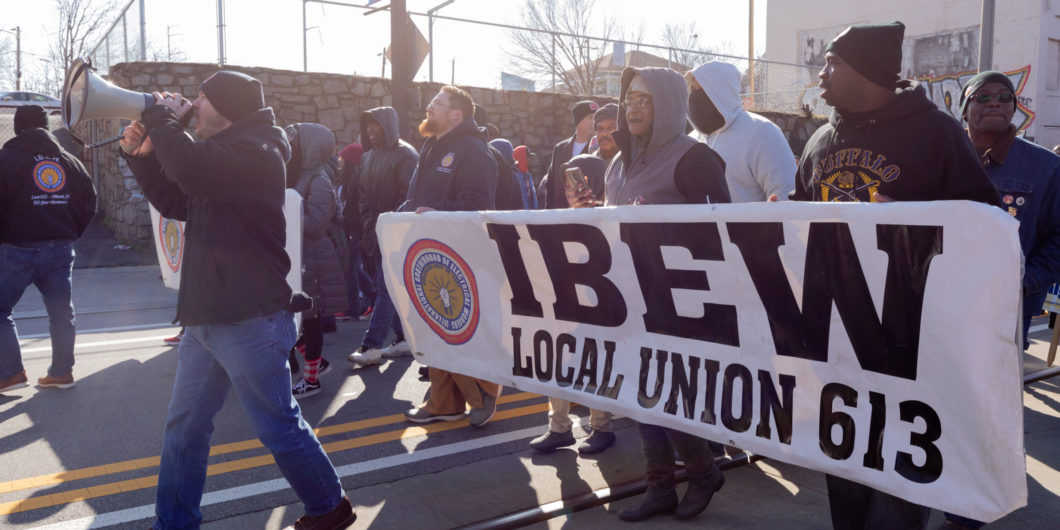Sir Gawain cautions readers not to make too much of manliness, of fearlessness in face of death, since even perfect knights may secretly flinch.
Adversarial Unions Are Not the Full Story
A year ago this month, full-time employees of Volkswagen’s plant in Chattanooga, Tennessee, voted to reject representation from the United Auto Workers (UAW) for the second time in five years. I can almost hear Richard Epstein saying, “Who can blame them?”
The UAW may still be America’s largest industrial union, but it’s no less a shell of its former self. At just under 400,000, the UAW’s active membership has fallen by half since the mid-2000s, and by two-thirds since its 1.5 million-member peak in 1979. For younger generations, whatever reputation the UAW earned for securing stable, middle-class jobs in the 20th century is now overshadowed by its contribution to the collapse of the U.S. automotive industry in the 21st century.
As a result, Chattanooga is home to the only Volkswagen plant in the world outside of China without worker representation. Volkswagen can hardly be blamed. The company hoped to bring the Germany-style work councils familiar to its other factories to its only American location, and was reportedly caught off-guard by the region’s intense hostility to anything resembling a union. Fears that unionization would force the plant to shut down, mongered by outside conservative groups and the Tennessee Republican Party, didn’t help matters. Yet, at the end of the day, the deeper barrier to worker representation lay in U.S. labor law itself.
Like Volkswagen, workers at the Chattanooga plant primarily wished to establish a work council: a shop-floor organization meant to represent workers on issues like workplace safety, scheduling, and ways to improve production. In contrast, a trade union provides exclusive representation to workers in multiple companies and locations across an industry. Nonetheless, U.S. labor law—specifically, Section 8(a)(2) of the National Labor Relations Act—makes it all but impossible to elect a work council without first joining a union. Joining the UAW was thus a means to an end, but one which the majority of workers ultimately deemed too costly.
Here, I find myself in complete agreement with Richard Epstein. As he notes in his Law & Liberty essay, Section 8(a)(2)’s ban on company-organized unions (and, by extension, work councils) exists precisely because company unions “work all too well” for workers and management alike, and thereby threaten to undermine the pull of independent unions. For workers at Volkswagen’s Chattanooga plant, however, the all-or-nothing prescription of the NLRA means they are now left with neither.
Created by and for the early 20th century, the NLRA has survived 85 years of congressional amendments, judicial interpretations, and changing social circumstances to become largely irrelevant, if not inimical, to our contemporary industrial organization. Meaningful reform is hard to come by, in no small part because the remnants of America’s labor movement—public sector employees, workers in a handful of industry incumbents, and retirees—have a strong interest in preserving the status quo. As a result, U.S. labor law is largely at impasse: a microcosm of America’s broader institutional decadence.
For its part, the UAW has tried on multiple occasions to shed its adversarial orientation in favor of the more collaborative model of labor relations common across Europe. Nevertheless, the structure of U.S. labor law means even good faith efforts to ape worker-management harmony are doomed to fail.
Remember the Saturn Corporation? A subsidiary of General Motors (GM), Saturn’s assembly plant in Spring Hill, Tennessee, was governed by an innovative labor contract that made employees owners, and exchanged profit-sharing for job flexibility and rigorous, results-oriented accountability. Despite enormous success in the 1990s, enthusiasm from UAW leadership quickly gave way to jealousy. UAW International requested they sign a standard labor contract three times and were thrice rejected. Saturn ultimately acceded to the UAW and GM in 2004 under threat of closure, yet the reverse was true. Finally back in the UAW fold, GM reallocated Saturn’s production outside of Spring Hill in 2007, not because the experiment failed, but because it was too much of a success.
Where I part company with Epstein is in his rejection of labor unions per se, rather than their particular instantiation in U.S. labor law. Most union-curious conservatives agree that adversarial unions are suboptimal, and instead draw inspiration from the cooperative and tripartite models of labor negotiation found elsewhere in the world. A move away from American-style enterprise bargaining could be achieved by replacing the NLRA with a new legal framework, or by deregulating labor relations entirely to allow innovative models to flourish. For example, many European countries maintain high rates of voluntary union membership by having labor organizations administer employee benefits like retirement funds and unemployment insurance (what’s known as the Ghent System). Such unions historically formed as an extension of mutual aid societies, although in the modern era they are typically recognized in law and supplemented by public funding.
…much like the UAW itself, Epstein’s mental model of organized labor is stuck in the 20th century.
Unfortunately, Epstein’s analytical arguments have virtually no bearing on those models, and in that sense, his essay attacks a strawman. Indeed, rather than debate thinkers like Oren Cass or Michael Lind on the substance of their ideas, Epstein declares them to be substanceless, and proceeds to spend the bulk of his essay rehearsing well-worn arguments against a model of labor relations that neither author promotes and that Cass explicitly rejects.
Whether American workers need unions is, of course, a much different question than whether American workers need particular regulations prescribing how unions can form and operate. Epstein provides an excellent deconstruction of the latter, but only tangentially addresses the former. As a result, his analysis neglects any discussion of the role labor organizations often play as non-governmental providers of job training and social insurance, or as a dynamic substitute to the administrative state in the promulgation of sector-specific regulations.
Epstein’s quixotic conflation of unions with a specific model of unionization leads him to assert that, as a kind of monopolist, the benefits of unionization “do not come from increased productivity, but from its ability to raise price above marginal cost,” where the “price” in this case are wages. That may be true of the textbook model of a monopoly, but it’s patently false as a generalization of what unions do.
In Germany collective bargaining was associated with wage restraint, as German trade unions agreed to push wages below marginal productivity in an effort to boost the competitiveness of their exports. Sectoral bargaining models, in contrast, reward businesses that invest in labor productivity by steering competition away from the mere externalization of labor costs. This occurs because workers in two or more competing firms within the same sector have their wage negotiated in common. Firms that find a way to boost worker productivity above the prevailing wage thus earn a rent, which is dissipated by competition overtime until the market settles at a higher-wage, higher-productivity equilibrium. Nordic countries all have union density rates at or above 70 percent, and generally determine wages through industry-wide collective bargaining agreements. Nonetheless, they are also incredibly productive and open economies, and routinely rank as some of the freest markets in the world.
Whether any of these models can or should be emulated in the United States is debatable, to say the least. Yet you wouldn’t know that they even exist from Epstein’s essay. Instead, much like the UAW itself, Epstein’s mental model of organized labor is stuck in the 20th century. Growing conservative interest in new models of labor organization must likewise be suppressed, it seems, lest they prove too successful.



